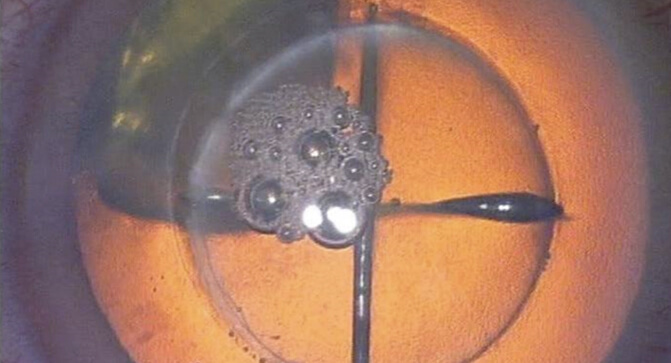Cataract Procedure
Essentially, there are two ways of removing cataracts: the traditional way of removing the whole cataract in one piece through a larger incision of 6–11mm and the newer way of first dividing the cataract into smaller pieces and then sucking them out through a much smaller 2–2.5mm incision.
Phacoemulsification (Phaco) uses ultrasound energy to help soften and then remove the cataract. This is the a well-established technique in cataract surgery and most cataracts are performed this way. It has been shown to be safe, predictable and gives excellent visual outcomes with low residual refractive errors.
Phaco Prechop is a supplementary technique to phaco in which the hard lens centre or nucleus is first divided into halves and then quadrants for easier removal by the ultrasound probe thereby reducing the amount of ultrasound energy dispersed in the eye. Grooving the nucleus as seen in the phaco picture above is not necessary.
Femtosecond Laser Assisted Cataract Surgery (FLACS) is a high-tech way of performing cataract surgery and is certainly effective. A femtosecond laser is used to pre-cut the cataract into fragments prior to phaco. It is important to realise that FLACS introduces one more element into the cataract surgery procedure which will take slightly longer and cost more.
There are however definite advantages when performed properly in certain cataract types. FLACS reduces the amount of ultrasound energy necessary to divide the hard cataract nucleus. In addition, it is able to make a perfectly circular and precisely sized anterior lens capsule opening through which a lens implant is inserted and this results in better lens positioning. This reduces the incidence of lens implant movement and rotation after implantation.

Perfectly circular femtosecond laser opening of the anterior lens capsule and precise quartering of the cataract nucleus facilitate easier removal with less use of ultrasound energy
Other ways of reducing the size of the cataract nucleus so that a small 2.5mm incision can be used involve snares, loops or wires to divide a nucleus and whilst in the hands of trained surgeons can they deliver good results, they have not been widely adopted.
Extracapsular Cataract Extraction or ECCE is a technique that used to be the most commonly performed cataract technique and was a reliable, low-cost surgical procedure. The main limitation was that the incision size was usually 10–12mm in size and required 5–7 sutures to close the wound. These sutures in turn could generate significant astigmatism which significantly degrades visual quality. Whilst some less developed countries still use ECCE, by and large it has been superseded by small incision techniques as described above.
Manual Small Incision Cataract Surgery or MSICS is a technique in which special wound construction and surgical technique modification allows a whole cataract nucleus to be removed through a moderate 6mm incision which does not need suturing. It is however a more challenging technique.

